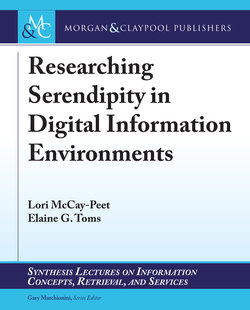Читать книгу Researching Serendipity in Digital Information Environments - Lori McCay-Peet - Страница 8
На сайте Литреса книга снята с продажи.
ОглавлениеPreface
Serendipity…the word conjures up an image of that fortuitous finding, one that evokes a happy human response. From its unassuming roots in literary scholarship in the Georgian era, the concept emerged in the 20th century to represent fortuitous discoveries perceived to be by chance, but clearly informed by significant knowledge and experience. Often equated with scientific discoveries it has evolved to be now associated with that unexpected but informed outcome in the social sciences and humanities and indeed in everyday life.
When we think of serendipity in digital information environments, we are constrained by physicality of that setting—the digital device, and also by the range of activities that may occur within that space and contexts. This book starts with an understanding of its initial origins and application and transfers that understanding to its application to and evolution in digital spaces. It examines the motivation for a renewed and intense interest in serendipity in research and development (R&D), and identifies the various interpretations of serendipity (e.g., event, outcome, process) that have been made to inform a better understanding of where and how to approach the concept in R&D. It examines how we can and do facilitate serendipity in digital spaces, and how, methodologically, to research the concept in these spaces.
To start such a work, we put our assumptions and perspectives about serendipity aside, and began with a “clean slate.” We conducted a systematic review of the research on serendipity, first searching broadly in four databases (Web of Science, ProQuest, EBSCO, and ACM Digital Library) for papers that serve as the basis for Chapters 2–5. In May 2016, we downloaded 1,293 citations but after removing duplicates and doing an initial cull based on title and abstract to ensure topic fit, we selected 550 for a closer look. From these, as well as papers subsequently gathered through other methods (e.g., citation chaining), we selected approximately 100 papers that met the following conditions for a more thorough examination.
• Paper was a published, peer-reviewed study of serendipity in digital environments; literature reviews, conceptual papers, and theses were not considered in the systematic review.
• Papers that mentioned serendipity only superficially were not considered.
• No restrictions on how authors defined serendipity.
• Research was empirical, using either or both qualitative or quantitative methods, but with no restrictions on method or methodology.
• No restrictions on research area or topic with respect to:
° information use environment (e.g., work leisure, learning, commerce);
° domain, field, or area (e.g., science, history, education);
° platform, application, or service (e.g., Twitter, WorldCat);
° type of digital device (e.g., mobile, laptop, wearable); and
° content or its format (e.g., text, image, sound).
Seminal works that do not meet the above criteria (e.g., Merton and Barber, 2004) are also referenced throughout the volume, but by conducting the systematic review, we hope that we have provided a useful “state-of-the-art” synthesis of the research on serendipity in digital information environments.
Lori McCay-Peet and Elaine G. Toms
July 2017
